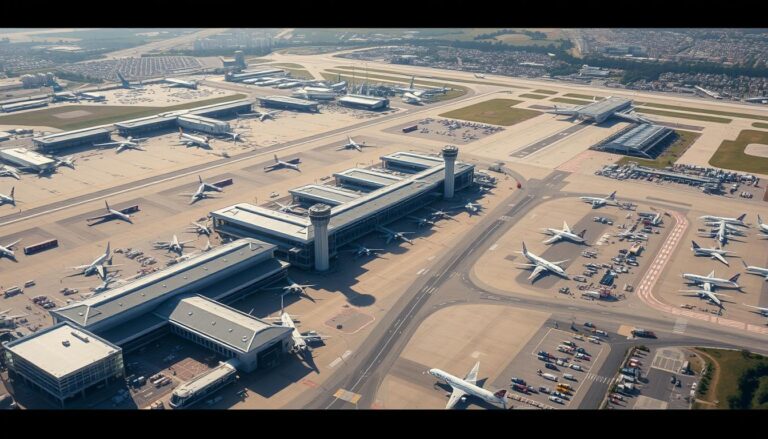When it comes to air travel within Europe, a few select airports stand out due to their immense size and passenger traffic. These largest airports in Europe are not just transportation hubs, but also remarkable feats of architecture and logistics. They play a crucial role in facilitating European air travel and connecting the continent to the rest of the world. The recent data reveal how these airports have bounced back from the COVID-19 pandemic, showing significant growth in passenger numbers.
London Heathrow Airport, the busiest of them all, reported a staggering 79,151,723 passengers in 2023, a notable 28.5% increase from the preceding year. This major European air hub consistently ranks at the top, epitomising efficient management and superior infrastructure. Similarly, Istanbul Airport follows closely with 76,236,980 passengers, marking an 18.2% growth and securing its position as one of the biggest European airports.
Paris Charles de Gaulle Airport, another giant in the European air travel landscape, accommodated 67,421,316 passengers in 2023, showing a clear recovery with a 17.3% increase. These numbers are a testament to the importance of these top airports in Europe. They are not only gateways to numerous destinations but also critical to the economic and social fabric of the regions they serve. Besides these, Germany’s Frankfurt am Main Airport handled 59,359,539 passengers, demonstrating robust growth and confirming its spot among the busiest hubs.
The grandeur of these airports is reflected not only in passenger statistics but also in their ability to continuously evolve and expand. As travel steadily resumes, the largest airports in Europe are more than ready to meet the demands and ensure seamless transport across borders. Their role in revitalising European air travel cannot be overstated.
Introduction to Major European Air Hubs
You are about to embark on a journey through major European air hubs, the beating hearts of international connectivity. These bustling centres of transportation do more than just facilitate your travels; they are integral components of the continent’s economic and social fabric. From serving millions of passengers annually to nurturing global business ventures and delightful tourist experiences, these international airports in Europe stand as pillars of modern infrastructure.
Imagine stepping through the bustling terminals of London Heathrow or gazing out over the vast expanse of Istanbul Airport’s runways. These hubs are not just among the largest in Europe but also rank prominently on a global scale. The intricate airport infrastructure in Europe supports seamless connections, ensuring that your journey is smooth and efficient, be it for business or leisure.
To illustrate the scale and connectivity of these major European air hubs, consider the following:
| Airport | Country | Connected Airports |
|---|---|---|
| Frankfurt Airport (FRA) | Germany | 330 |
| Istanbul Airport (IST) | Turkey | 309 |
| Charles de Gaulle Airport (CDG) | France | 308 |
| Amsterdam Schiphol Airport (AMS) | Netherlands | 293 |
| Leonardo da Vinci International Airport (FCO) | Italy | 239 |
| Vienna International Airport (VIE) | Austria | 221 |
| Munich Airport (MUC) | Germany | 216 |
| Adolfo Suárez Madrid–Barajas Airport (MAD) | Spain | 214 |
| London Gatwick Airport (LGW) | United Kingdom | 213 |
| Barcelona-El Prat Airport (BCN) | Spain | 210 |
| Manchester Airport (MAN) | United Kingdom | 210 |
| London Stansted Airport (STN) | United Kingdom | 209 |
| Zurich Airport (ZRH) | Switzerland | 205 |
In 2023, passenger traffic surged by nearly 21% at the largest international airports in Europe compared to 2022, although this still remains 6.5% below the pre-pandemic peak. This growth demonstrates resilience and an upward trend in air travel, reinforcing the paramount role of these hubs in global mobility.
As you navigate these prominent international airports in Europe, their comprehensive facilities and extensive networks transform your travels into more than just a journey—they become gateways to unforgettable experiences. The sophisticated airport infrastructure in Europe is engineered to support this dynamic flow of passengers, goods, and culture across the globe. With each airport interlinking numerous destinations, they collectively contribute to the tapestry of global connectivity.
Indeed, the major European air hubs serve as indispensable nodes in the expansive network of air travel, solidifying Europe’s position as a truly interconnected continent. As you traverse these corridors of movement, you become part of an ever-evolving story of global exploration and togetherness.
The Largest Airports in Europe
When evaluating the busiest airports in Europe, several key players stand out based on airport traffic and size. The following four giants lead the rankings, reflecting their immense scope and volume of passenger transit. These include London Heathrow, Istanbul Airport, Paris Charles de Gaulle, and Amsterdam Schiphol.
London Heathrow Airport
London Heathrow Airport stands prominently at the top of the airport rankings in Europe. Handling an impressive 79.1 million passengers in 2023, Heathrow is not only the busiest airport in Europe but also a crucial international hub. Covering an area of 1,227 hectares, it efficiently manages a substantial share of Europe’s air traffic, contributing vastly to global connectivity.
Istanbul Airport
Istanbul Airport’s strategic position at the crossroads of Europe and Asia makes it a significant player in European airport statistics. Ranked second by accommodating 76.03 million passengers in 2023, it occupies 760 hectares but boasts the highest passenger traffic among major European air hubs. The facility’s cutting-edge infrastructure ensures a seamless travel experience for millions of travellers.
Paris Charles de Gaulle Airport
Paris Charles de Gaulle Airport is a key gateway not only for France but for Europe at large. Serving 67.42 million passengers in 2023, it holds the third spot in airport traffic Europe. Its vast expanse of 3,257 hectares supports an extensive network of flights, reinforcing its crucial role in connecting Europe with the rest of the world. The airport’s dedication to efficiency and passenger comfort sets a high standard in the aviation sector.
Amsterdam Schiphol Airport
Amsterdam Schiphol Airport ranks fourth among Europe’s largest airports, with 61.89 million passengers passing through its terminals in 2023. Spanning 1,125 hectares, Schiphol is renowned not only for its passenger traffic but also for its innovative design and services. It stands as a model of modern airport architecture and management, contributing significantly to the dynamism of European air travel.
These statistics highlight the pivotal role that these airports play in handling the largest share of passengers in Europe, effectively shaping the continent’s aviation landscape. They underscore the significance of infrastructure, strategic location, and efficient management in maintaining their positions as major global air hubs.

